11 ways to take your veterinary practice from chaos to cakewalk
These techniques on low-stress handling in a practice will save you, your patients and staff from everyday stressful events.
Have your cake and eat it, too
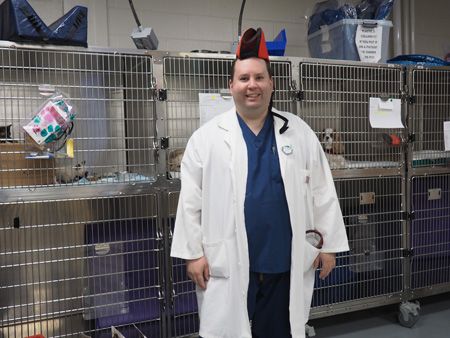
It's time to lower stress: "party hat" optional. Photo courtesy of Dr. Michael Nappier.

Scruffing isn't fun for humans, either. Photo courtesy of Dr. Michael Nappier. We know life isn't always a party, and everyday stressful events in practice can bring you, your clients, staff and patients down. Be proactive, put your "party hat" on and take steps to ease the stress! We use these easy techniques to dial tension down and avoid reaching for the scruff.
Approaching a fearful dog
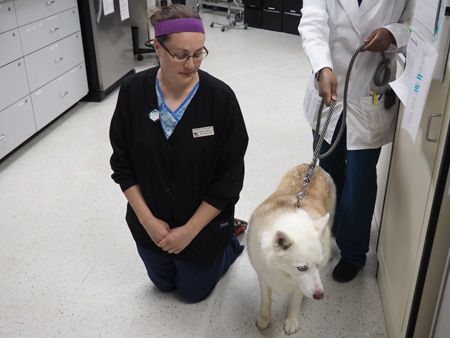
Photo courtesy of Dr. Michael Nappier. For most of us, our natural reaction when we see one of our canine patients is to hug it and love it and squeeze it to pieces! But nervous dogs can see a confident front-on approach as a frightening threat. For dogs showing signs of fear, try getting down on their level and approaching them from the side, remaining parallel with them. Never face them head on or move over the top of them. You can perform your entire physical examination form this position.
Getting a heartworm test from a stressed dog
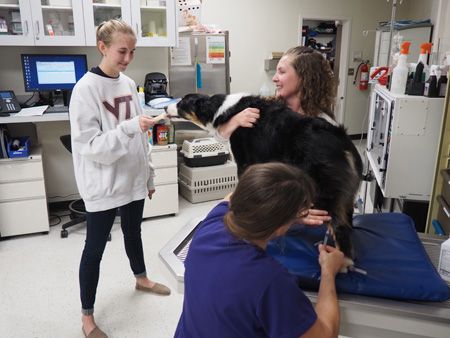
Abra cadabra! A stress-free heartworm exam in action. Photo courtesy of Dr. Michael Nappier.

The cheese cone: better than a magic wand. Photo courtesy of Dr. Michael Nappier. When all you want are a couple drops of blood, it sometimes feels like you need a magic touch to get them. Use a real magician's trick: misdirection. Keep the dog occupied up front with something delicious like a cheese cone while the magician sneaks around behind and gets the sample.
Giving Bordetella bronchiseptica vaccinations to dogs
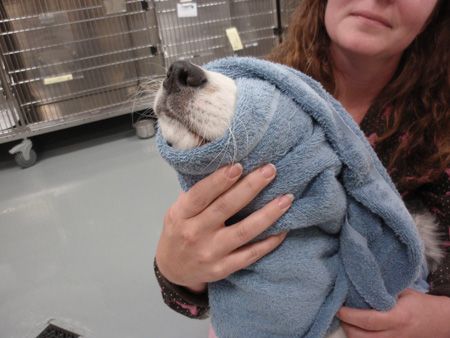
Photo courtesy of Dr. Michael Nappier. How many Bordetella vaccines have you given that you felt like you got more of it than the dog did? "Out of sight, out of mind" is the best method for some dogs. Snugly wrapping a large fluffy towel around the dog's face and snout keeps them less aware and affords you some bite protection.
Administering sedation to a stressed dog
Sometimes stressed dogs benefit most from light sedation, but just how do you inject the dog without anyone getting hurt? For this technique we borrow a little from hockey players-think hip check. Gently press your knee or thigh into the dog's shoulder while keeping control of the head with the leash/collar. This allows sufficient restraint on many dogs for someone to sneak behind and give an intramuscular injection.

Photo courtesy of Dr. Michael Nappier.
Lifting a resistive small dog off the floor

Photo courtesy of Dr. Michael Nappier. Sometimes this can feel like trying to pick up a landmine or reel in a flopping fish. For a less stressful option for the both of you, keep the dog moving forward using its leash and scoop them up from behind.
Restraining a defensive small dog
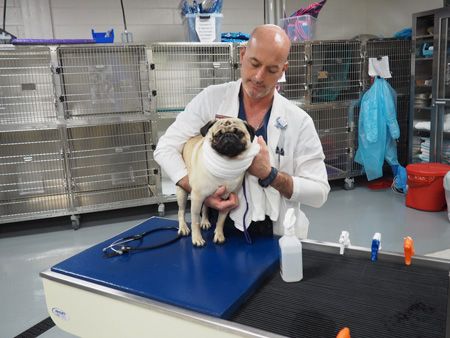
A simple towel wrap makes everyone a happy camper. Photo courtesy of Dr. Michael Nappier.
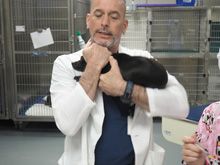
This restraint isn't worth the struggle and stress for anyone. Photo courtesy of Dr. Michael Nappier. What's the size of a football and slipperier than a greased hog? A small dog that doesn't want to be restrained. To make things easier, cradle the dog like a football keeping the body parallel to the ground. Add a simple towel wrap around the neck for head control and everyone can breathe easier.
Comfy control for ultrasound-guided cystocentesis in dogs and cats

Photo courtesy of Dr. Michael Nappier. Getting pee out instead of getting peed on is stressful sometimes. Belly-up and stretched out on their back is stressful for dogs, especially if they don't feel supported. Try a “V” trough-or even better, sit them in your lap so they feel supported and secure. It works for cats too!
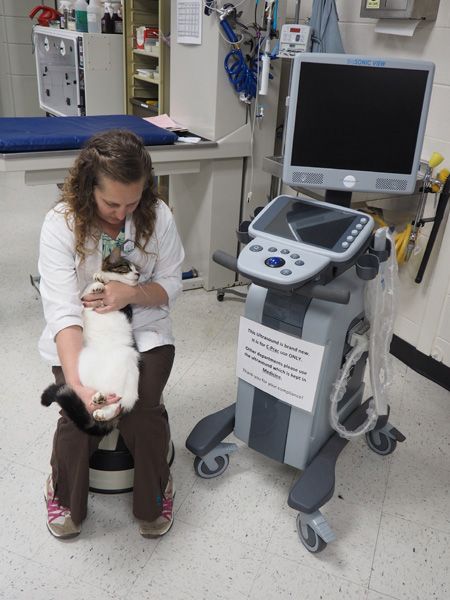
Photo courtesy of Dr. Michael Nappier.
Getting a fearful cat out of the carrier

Photo courtesy of Dr. Michael Nappier.
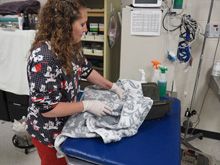
Photo courtesy of Dr. Michael Nappier. Soft kitty, warm kitty, little ball of sharp pointy things! Let's stop the scruff-and-pull or the dump-and-shake moves. Get out your big fluffy towel and work it between the halves of the carrier. This will allow you to either scoop up the cat and finish towel wrapping it or to restrain it for sedation.

Photo courtesy of Dr. Michael Nappier.
Getting blood from a cat's jugular vein

A simple ring hold should do the trick. Photo courtesy of Dr. Michael Nappier. For many cats, less is more. Cats sure seem braver than we are about needles, and a lot of cats resent the restraint much more than they do the needle poke. For this, a simple ring hold is enough for many cats. For felines that swat syringes with their paws, get the big fluffy towel and wrap the cat in an open burrito wrap.
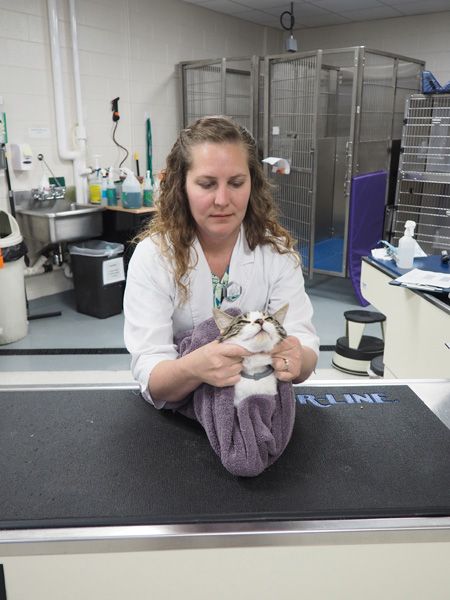
Snug as a bug in a rug... or cat in a towel. Photo courtesy of Dr. Michael Nappier.
Getting blood from a cat's saphenous vein
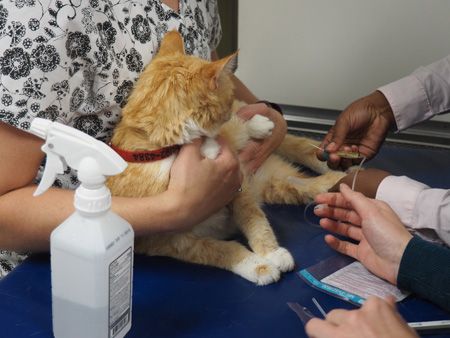
Photo courtesy of Dr. Michael Nappier.

Photo courtesy of Dr. Michael Nappier. Sometimes cats prefer giving blood from back legs instead of front legs. Again, for many, less is more. If you leave cats with their front end sternal, many will just sit there and watch you draw the blood. For those cats that need a little more help, grab your big fluffy towel and use a burrito wrap, leaving a back leg out.
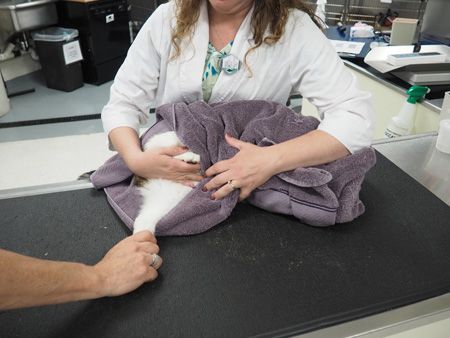
Photo courtesy of Dr. Michael Nappier.
Getting an IV into a reluctant cat

Voila! Your bundle of nerves is now (nearly) a bundle of joy. Photo courtesy of Dr. Michael Nappier. What do you do when you need IV access, but the cat has other plans? Break out the big fluffy towel again! A modified scarf wrap secures the cat's head, neck and body while leaving you access to a front leg or previously placed cephalic catheter.
Michael Nappier, DVM, DABVP
Department of Small Animal Clinical Sciences
Virginia-Maryland College of Veterinary Medicine
Blacksburg, VA 24061